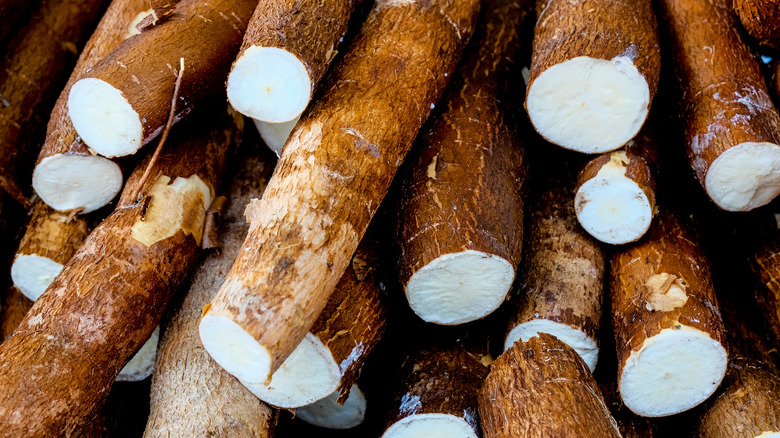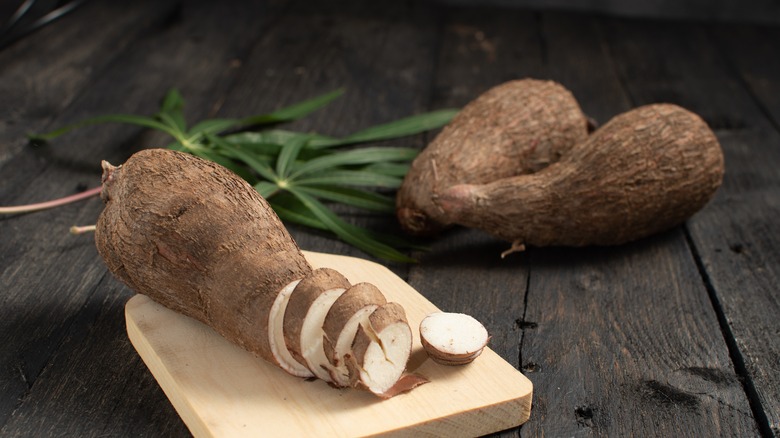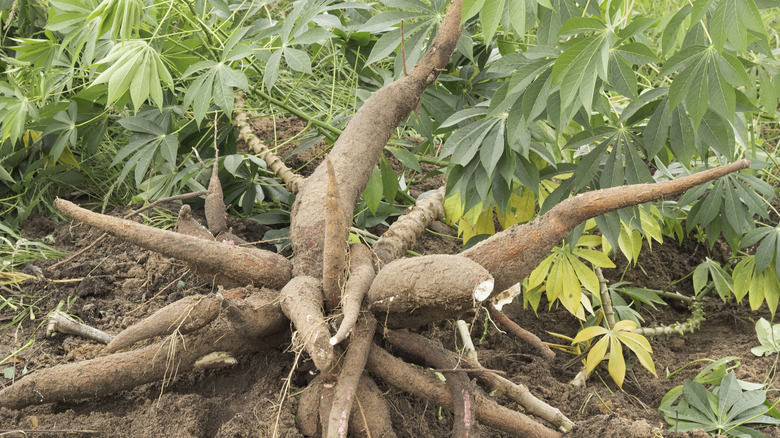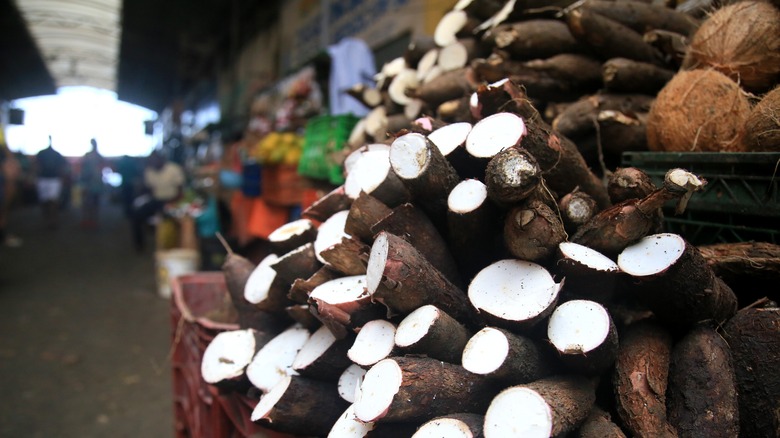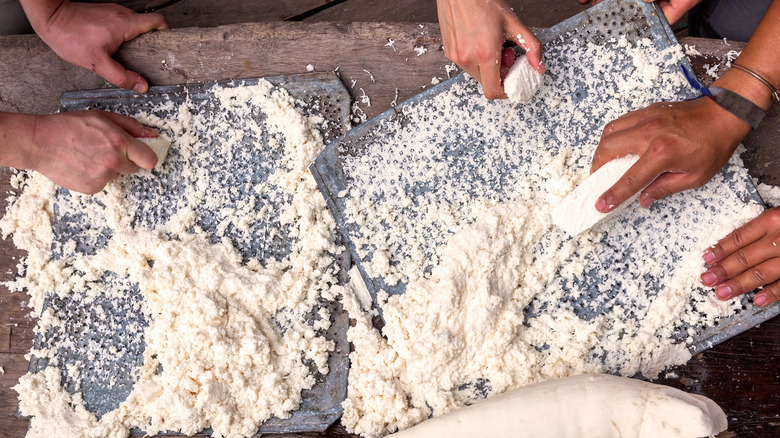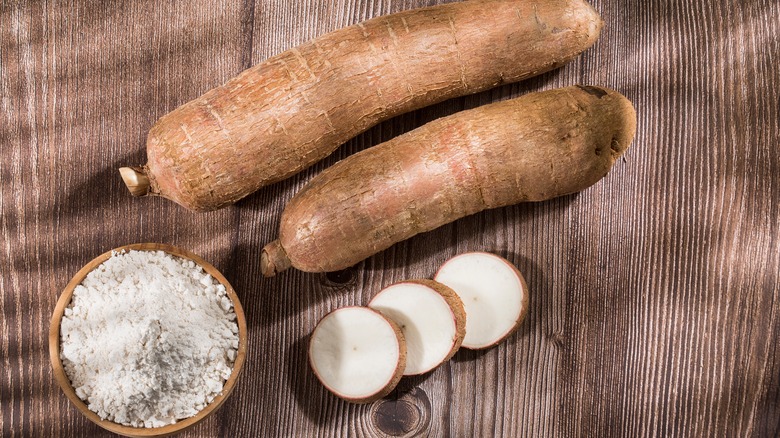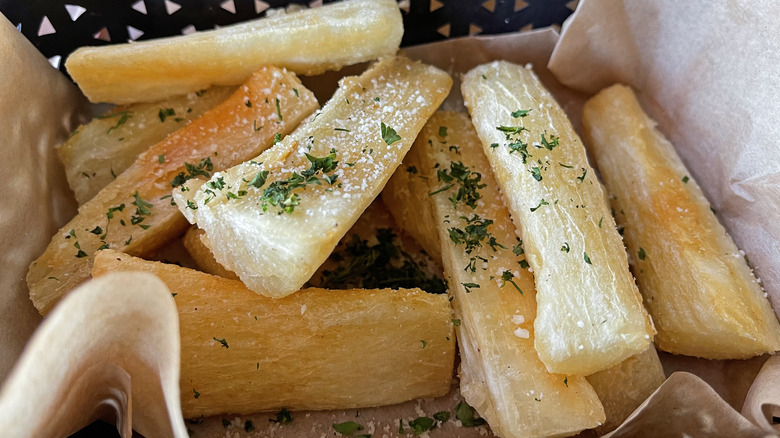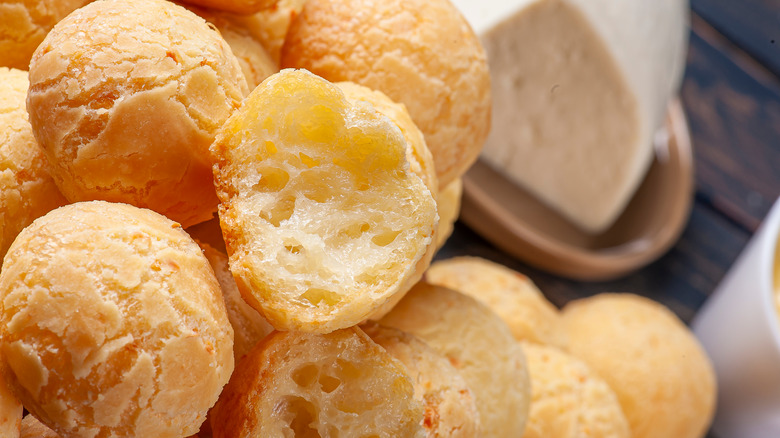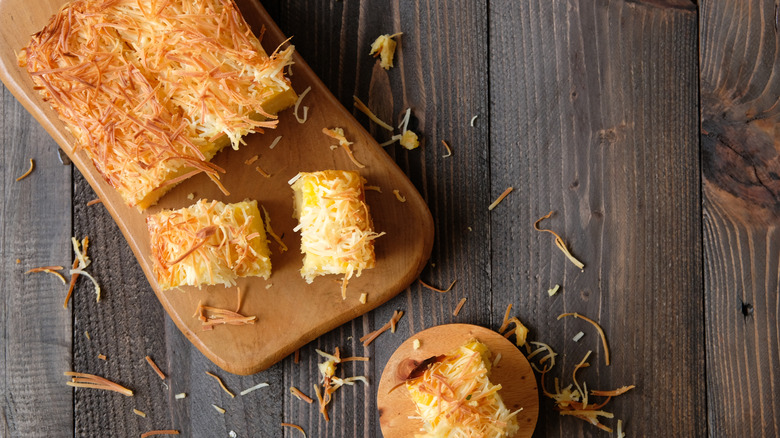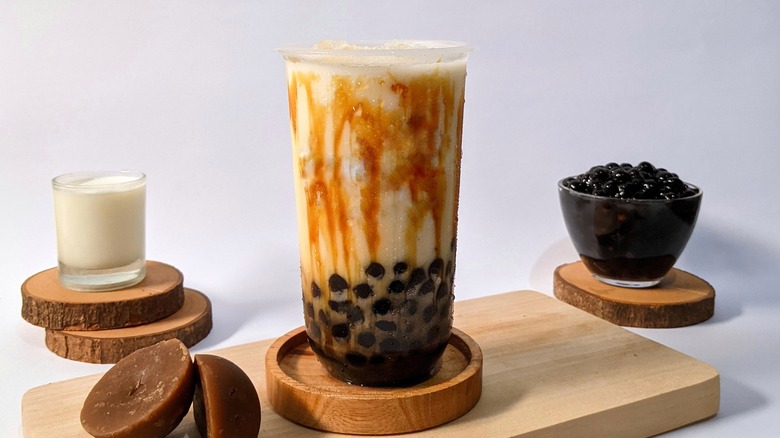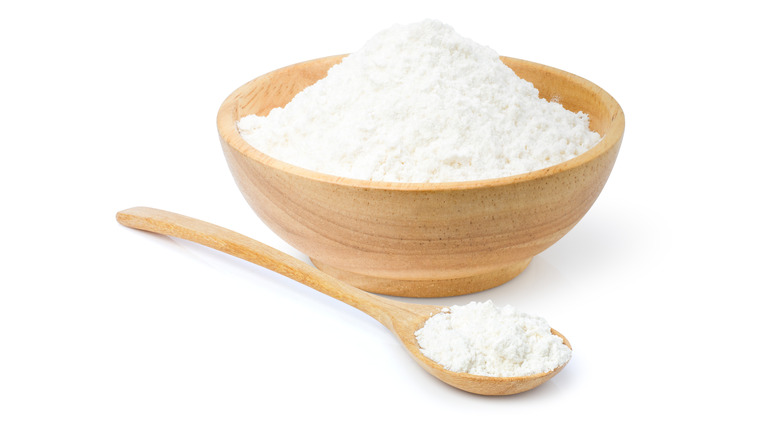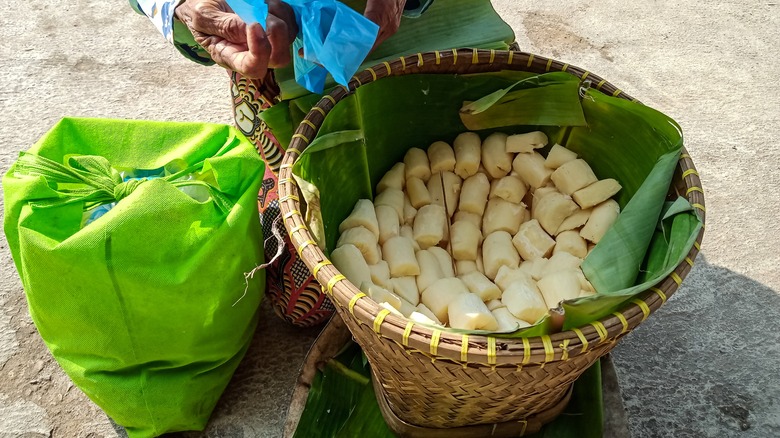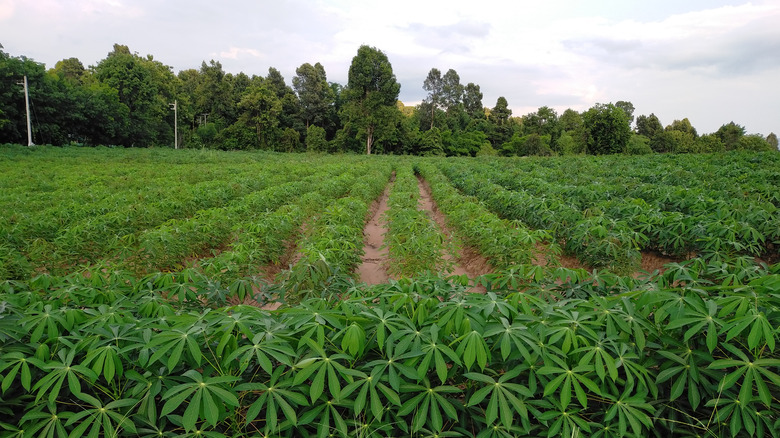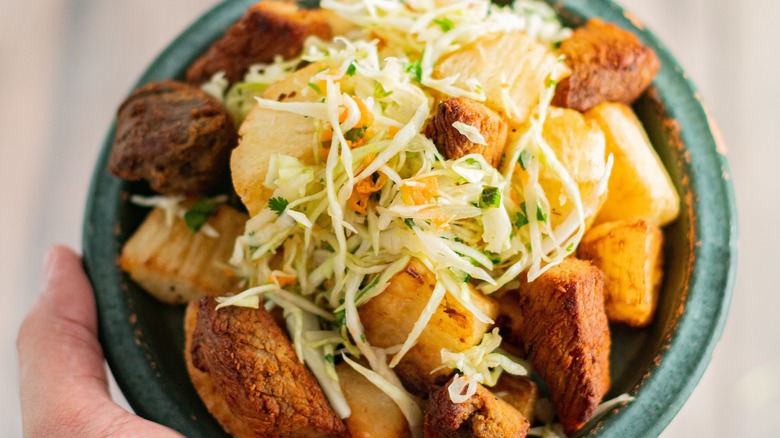Everything You Need To Know About Yuca
Yuca, also known as cassava, manioc, tapioca, and many other names is a root vegetable that originates from South America that is now eaten all over the world. In fact, yuca is so common in our everyday foods, cleaning products, and household items that you may not even realize how much yuca is around you at all times.
If you have ever seen this root in its raw form, you know that it is long, dark golden brown, and looks faintly like a potato or sweet potato. Beyond that, yuca does not look very exciting — but do not fall into that trap. Yuca is full of exciting flavors, textures, and possibilities if you simply open your eyes and your mouth. Yuca has a wonderful texture that is both dense and chewy, making it incredibly enjoyable to eat.
If this is the first time you are hearing about yuca, then keep reading and you are sure to learn lots about this fantastic starch. In fact, even if you have had yuca many times, this root is out to surprise you with its versatility and scrumptiousness.
Yuca is also known as cassava
There may be some confusion around different plants named yuca, and what other names yuca does in fact go by. So look no further.
Yuca is a root vegetable that is starchy and grown all around the world, mostly in the tropics. It is a common plant in the tropics because it does not require set seasons, and therefore can be planted and harvested about twice a year. However, in places that see a dip in their temperatures, growing cassava is not as possible because the plant is not cold tolerant. This means that the major yuca-producing regions are West Africa, Southeast Asia, and South America where coincidentally, or not, yuca is also heavily consumed and a huge part of the local diets. This root is also commonly known as cassava, manioc, or tapioca.
But, what about yucca? That extra "c" makes a world of difference when talking about the plant or food. Yucca is the name of a plant that has nothing to do with the cassava plant that produces the yuca roots that we eat. Yucca plants are spiky and produce a large bloom of white flowers each year that shoot up from a center stem. These plants, as stunning as they are, are not edible in the slightest and should remain ornamental.
Yuca is a root
Yuca is a staple starch crop that grows underground. Technically the root of a yuca plant, the roots grow from the crown of the plant and branch out into the soil in collections of long tubers. The roots can grow to be up to three feet long but, more commonly, are up to 12 inches in length. This fascinating plant produces fruit, roots, and leaves, but, the only edible part of the plant is the tuber itself. Yuca plants require well-drained soils, which means soils that are fairly sandy and do not hold onto water very well. This makes yuca plants drought tolerant and a great companion plant for small seedlings of cocoa or coffee plants. They can shelter the small seedlings while they are establishing themselves in new areas, especially in those that are quite exposed with little shade cover.
Yuca is technically a perennial plant, meaning that it does not die seasonally, and instead can live year-round. However, it is common to propagate a new yuca plant from a cutting, and then wait nine to eleven months for the roots to become large enough to harvest. In general, the roots are ready to be harvested when they are eight to fifteen inches long. The older the root, the starchier it will be. This may sound like a good thing, but be careful. If a yuca root gets too old, they will become starchy and the middle will be woody and fibrous.
Yuca looks like a brown, long sweet potato
This fantastic root vegetable is quite unassuming looking. It is dark brown in color with slightly shiny skin and small little hairs. If you find fresh yuca, and we mean truly fresh from the ground, it will be dusty from the soil and the skin will be softer since it has not yet had the chance to dry. Yuca that has traveled long distances — as is the case with much of the yuca found in the U.S. — the skin is often hardened and darker in color. This is due to the drying period the root goes through as it travels through the supply chain. Regardless of the freshness of your yuca, it will be delicious once you peel off that layer of skin.
Under the dark brown skin, you will find bright white flesh. If for some reason your yuca has any bruises or blemishes, you will be able to see them on the flesh because the color will be off-white. This indicates that this part of the yuca may not be good to eat, and it is best to cut it off.
Yuca can be toxic
This wonderful starchy vegetable is fantastic fried, steamed, baked, and fermented. The reason behind that is not entirely because of taste. Raw yuca contains a natural type of cyanide called cyanide glucosides that are found in the starch of the roots (via Britannica). In the past, to remove the toxic cyanide, indigenous peoples developed many ways to process the root to ensure that it was not poisonous (via American Indian Health and Diet Project). Many of these techniques, which include pounding, soaking, fermenting, and drying the yuca, are still used today in industrial yuca production.
There are two main types of cassava, a bitter and a sweet variety, and it is from the bitter variety that yuca and tapioca flour are usually made. Bitter yuca also has a much higher cyanide content and therefore requires additional care when being prepared for flour. When you are preparing yuca for yourself, make sure to peel the skin, soak the yuca pieces in water, and cook the yuca thoroughly until it is soft and tender (via Medical News Today). This will ensure that your yuca is cyanide-free and can be enjoyed with peace of mind.
Yuca is very starchy
You can taste how starchy yuca is all by yourself; don't just take our word for it. When you bite into a piece of fried or boiled yuca you will notice how dense and chewy the flesh is, as if it is just a starchier potato. Combining this high starch content with yuca's natural nuttiness and sweetness, you are bound to have a delectable time eating anything yuca-made.
Yuca is the third most important starch in the world, behind rice and corn, making it a beloved and invaluable staple crop. In 2013, the Food and Agriculture Organization of the United Nations predicted that yuca is the staple crop and calorie source for over 800 million people worldwide, which today would be even higher. Comparing yuca to pasta, yuca is 38% carbohydrates compared to pasta's 25% (via Food Struct). The root has around 198 calories per 100 grams, according to Healthline, and 84% of those calories come from starch. Now you may understand a little bit more about how yuca and its starch are more than just satisfying to eat; it is essential to many people around the world.
Yuca is delicious fried
So, we can finally talk about how delicious yuca is. One of the most delicious ways to prepare and eat yuca is by frying it. As we previously mentioned, yuca is very starchy, so having a yuca fry, or yuca frita, is like biting into a starchier french fry.
You can make yuca frita by simply peeling your yuca, cutting it into fry-shaped pieces, and soaking it until your oil is hot. Fry your yuca pieces until they are crispy and slightly brown. If you really want extra luxurious yuca frita, then make sure to twice fry the pieces. This will crisp up the grooves and edges of the yuca, making it absolutely divine to bite into.
If you do not feel like going through all of the efforts of frying your own yuca, you can find yuca at many grocery stores, such as Trader Joe's cassava chips. While the chips are different from a freshly fried yuca frita, they still have the signature yuca crunch and flavor.
Yuca is also delicious baked
If you have ever had yuca, you will know what a great texture it has. Thanks to its high starch content and its inherent bounciness, baking with yuca produces items that are chewy, dense, and satisfying. It may surprise you, but yuca is actually the base of tapioca, and while using tapioca flour is not the same as yuca four, they do come from the same root. Therefore, you can imagine how chewy and delectable items baked with yuca flour are.
Whether you are baking with yuca or tapioca, you will be sure to be delighted with the results. One of the best ways you can enjoy yuca in its baked form is through Brazilian pao de queijo recipe. These little cheesy and chewy snacks are scrumptious. They have a salty, irresistibly cheesy flavor and the most satisfying chew that in some ways resembles mochi or a mochi doughnut. What is there not to love?
Yuca would never forget about dessert
Yuca, being one of the world's staple starches, cannot be restricted to only savory applications. As with any crop that can be made into flour, yuca can be made into desserts. Often times this is seen through the use of tapioca in puddings or drinks or with yuca flour in dense, buttery cakes.
Somewhat like butter mochi in texture, a Filipino cassava cake recipe actually uses neither yuca flour nor tapioca to achieve its signature texture and flavor. Rather, this soft cassava cake uses fresh cassava that must be grated before being mixed into a batter and baked. It is then topped with a drizzle of coconut milk and sweetened condensed milk that makes this cake even gooier and irresistible.
If this cake sounds like it would be delicious, you are right. Make sure to give it a try next time you encounter some fresh yuca, and you will not be disappointed.
Yuca is to thank for your boba
Boba, otherwise known as bubble tea, is tea made with tapioca pearls. This beloved drink goes by many names, but whatever you would like to call this Taiwanese tea that has swept across the world, it is undeniably popular and has a growing fan base. Boba pearls are often black and slightly glassy looking with an addicting chew that makes them very satisfying to slurp up and chew. These pearls make it both a drink and a snack because drinking boba tea is a process that cannot be rushed.
And where do these boba pearls come from? You guess it, yuca. The pearls are made out of tapioca and tapioca flour that is derived from yuca starch. So, next time you are enjoying a giant cup of boba tea in one of the countless flavors it comes, make sure to remember its roots and the long history that allowed you to enjoy this wonderful treat.
Yuca produces tapioca
While tapioca is another name for yuca and cassava, there is a slight difference between the two items. Tapioca flour comes from the pulp of the yuca plant while cassava flour is made from the entire root. More specifically, tapioca comes from the bitter variety of yuca that is believed to have arrived in South East Asian and Taiwan through Japanese occupation in the late-1800s (via Eater). The starch must be extracted from the pulp of the yuca plant, treated to rid it of the natural cyanide, and then dried into a flour form that we can find at all of our local stores.
This means that everything tapioca, tapioca pearls, tapioca pudding, and tapioca flour are made from the pulp of the yuca plant rather than the whole root. Because only the starch is used, tapioca flour, and its products, tend to be chewier and less tough than things made with cassava flour. When you are baking with tapioca flour versus cassava flour you can even tell the difference. Tapioca flour is finer and feels sort of like corn starch, while cassava flour is not as smooth and silky.
Another use for tapioca flour is as a replacement for corn starch or potato starch. If you are frying something or making a slurry to thicken a sauce, tapioca flour can be substituted for the same results.
Yuca is important around the world
So, what about yuca makes it such an important root? The answer is starch, but it's also dense in calories and nutrients. And, while in the U.S. the keto diet and other low-carb diets are rising in popularity, around the world many people rely on yuca and other staple starch crops to reach their daily calorie intake.
Yuca is one of the world's top sources of carbohydrates when compared to other staple crops like rice and corn, and today, cassava is eaten by an estimated 500 million people worldwide, according to the Agricultural Research Council. Cassava was introduced to the Congo basin by the Portuguese in the mid-1500s (via IITA), and since then this root has grown in significance. You can find it mashed into fufu, steamed in a banana leaf, baked into a bun, or fried into a torpedo and stuffed with meat. In addition, cassava is also used to make glues, paper, textiles, and plywood. Regardless of how yuca is used, its versatility for many communities around the world is remarkable.
Yuca originated from South America
While the majority of yuca is grown in Africa, yuca actually originates from South America from the area that is now known as Brazil. It comes from a dry basin called the cerrado where it was domesticated and was domesticated an estimated 10,000 years ago (via We Seed Change), and then began its steady takeover of the world. The indigenous peoples of South and Central America were known to enjoy their yuca boiled, in porridge, or shaped into a dense, round cake, according to the American Indian Health and Diet Project. Their knowledge of how to cultivate and process yuca helped establish the massive yuca industry that we have today.
Today, yuca still plays a huge role in Brazilian and South American cuisine. It can be found as a crispy side called farofa, boiled and topped with vinegar and onions, or in a simple crepe called tapioca. However, if you eat this starchy root, it will be sure to satisfy while delivering a mouthful of satisfying chew, crunch, and most importantly, carbs.
Yuca is good for your health
Yuca has many nutrients that are beneficial for your body. To begin with, yuca is very high in Vitamin C, with 20% of your daily value coming from only 100 grams of cooked yuca (via Healthline). Vitamin C is great for your immune system and also acts as an antioxidant in your body.
Yuca also has a significant amount of potassium and copper, which are good for muscle function and health (via WebMD). Lastly, WebMD also explains that yuca is a great source of resistant starch for digestion and also is a good way to stabilize blood sugar. If you are looking to mix up your cooking game and would like to add some new starches to your diet, try giving yuca a whirl and see if you like it. This naturally gluten-free, chewy, and carb-rich root is so versatile that everyone can find something to love and appreciate.
